Recently, I attended a business mastermind at Boise, Idaho. It was a significant investment, but the value of being able to chat with the high-level entrepreneurs that attended was worth the price tag.
So in my head, before I got to this event I thought the whole thing (all the presentations and everything that was going to be shared) was going to be next level stuff almost. Things that I would have never even thought of! And honestly there were a few things like that, but the majority of it really was bringing people back to the basics.
I'm really happy that I went to the mastermind group in Boise, Idaho. I will be going again. What I took away from it in my notebooks, which is seriously pages and pages of notes, is that the basics are the most important. It really doesn't matter where you're at.
To keep with that, I’m going to share the basics of drop shipping and go step-by-step on how drop shipping works! Check out the video or read my transcript at the bottom. If you have friends or family that are still confused about how you’re making your money, this is the perfect post to share!
Part 1: Choosing a Profitable eCommerce Business Model
The question I’m asked most often is, “How do I dropship profitably?” It’s a very broad question with an answer that is seven+ modules long (DSL’s main course)! The truth is that anyone can start a dropshipping store, but to be successful you have to follow certain steps.
In this series, I’ll show you the basics of how to dropship profitably. To make it easier I’ve broken it down into three parts:
- Overview of eCommerce models and dropshipping explained
- 7 things you need to do to succeed in dropshipping
- 5 mistakes you should avoid with your dropshipping store
These three parts will give you a fundamental understanding of dropshipping. That way you can start your dropshipping business with a better foundation and succeed quicker.
Three Common eCommerce Business Models
Before we talk about dropshipping specifically, let's examine three different eCommerce business models. That way you can get a clear idea of your options and which one will work best for you.
First, let’s look at eBay. eBay is a well-known auction website, but did you know you can setup an eCommerce storefront? With the traffic that eBay brings in, it can be tempting to try this eCommerce business model.
Next is Amazon, the biggest eCommerce store in the world. Building a storefront in Amazon makes it easier for your customers to buy. Also, you get more trust upfront by selling on Amazon.
Finally, there is Shopify. This platform allows you to create your own independent storefront. With Shopify, you’ll have much more control than with other options and some significant advantages in marketing.
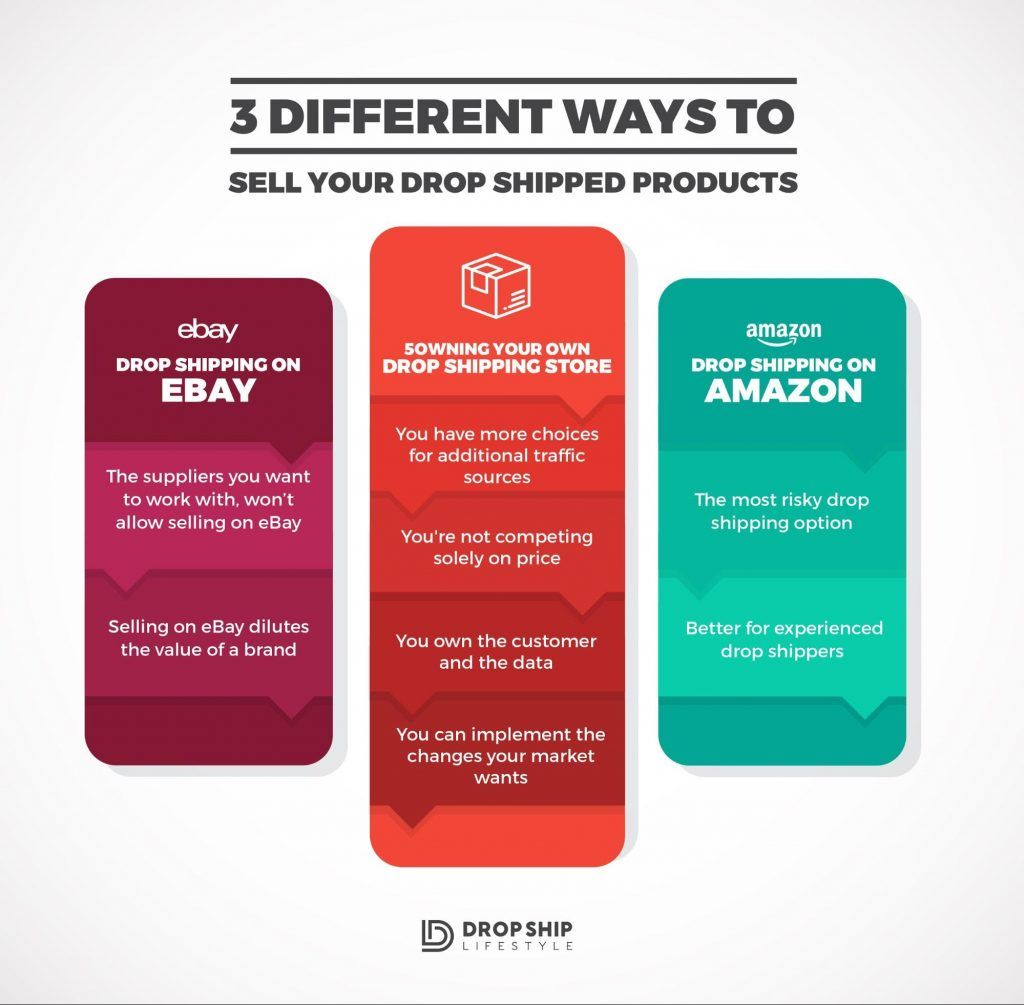
Shopify Dropshipping, Amazon Dropshipping, eBay Dropshipping
There are more but these are the big three. You could sell on Amazon, eBay, or you can build your own store with Shopify. Out of all the options, you could go with I suggest you use Shopify (It’s what we teach in our main course). Go with Shopify and build your own store.
The reason I suggest Shopify is because it allows you to own everything. When you're selling through eBay or Amazon, things really come down to pricing. By using these two platforms you risk getting caught in pricing wars because customers can check out competitors all on the same site.
This is a problem because often times you won’t be able to compete in price with other sellers on these platforms. That or if you do win, you will have lowered the price to the point where you make little to no money on it.
When you build your own store, you control everything. The content, leads, and customer data is all yours. This gives you more power with your marketing and advertising. It enables you to control how many people buy through your website. I highly recommend building your own store out of all these business models, and again I suggest using Shopify.
Finding Products To Sell
After deciding on your eCommerce model it’s time to move on and discover how you get products to sell. Just like the business models, you have a couple of options.
One option is importing. I’ve imported before, from China to the USA. You could import from anywhere to anywhere and it is a good way to do business. It's a good way to get involved with eCommerce, but I do not recommend starting that way. That’s because of the startup and warehousing costs associated with importing.
Another method that I actually can't believe people recommend is going to garage sales. Basically, you travel around and find good deals then resell them at your store front. Think of the show American Pickers.
The last option is dropshipping and it’s the clear winner. It’s the best way to start in eCommerce, that’s why I built my program on it.
I’m not saying importing is bad or that you should never do it. But if you're:
- Just getting into eCommerce
- Trying to really learn the ropes
- Don’t want to put a lot of capital upfront
Then dropshipping is the way to go. It's the best return on your time and it’s a way to really create a profitable business that doesn't cost a lot of money upfront.
And obviously, the garage sale thing (that courses actually teach!) is not viable. It's a waste of time and effort to sell one item at a time. We want to sell lots of items and make a lot of money.
How Dropshipping Works
Now that you know why I recommend dropshipping it’s time to break down how dropshipping works.
This image shows the dropshipping process but let me break it down further for you.
It starts with building your own eCommerce store and listing products on your website. You create this store on Shopify and customize it to fit your audience.
But whose products are you selling? Well, these are different suppliers’ and brands’ products. You may be thinking, “why don’t these companies sell their products directly?” The thing is there are companies that only focus on innovating products that rely on retailers to sell them.
That’s where you come in as a dropship retailer, you’ll be selling for these brands who don't sell to the public. They look for people to sell their products, to make them money, and grow their business for them. You are one of these retailers.
You’ll want to focus on getting approved to sell for these different companies. After you’re approved you’ll put their products on your Shopify store. Then you will advertise to bring people to your store.
Customers come to the store, and after they purchase, you contact your suppliers. Then they ship the items directly to the customer. You aren’t buying any inventory. All you’re doing is making an agreement with the dropship supplier to sell their products on your website.
You get their price lists and put their products for sale on your site. When someone buys, you place that order with the supplier. You only order the product after the customer has paid you. Then you’ll contact that supplier, and say “ship item XYZ to customer ABC.” Then they ship it and charge you.
The difference between your retail price and what you pay your supplier is the net profit. From my experience, when you dropship the right way, you're looking at about 25 to 30 percent average net profit. That means if you sell a $1,000 item, you make $250. That's the average I’ve seen in my experience. Sometimes it's higher, sometimes it's lower, but that's a good goal to shoot for. It's a realistic expectation.
Now that you have a good overview of what dropshipping is and what it can do for you, you’re ready to see the steps to being successful in eCommerce. The next part of this article covers the seven steps I use to create each successful dropshipping store.
Part 2: The Seven Steps To Success In Dropshipping
Think of these seven steps as a checklist for every time you build a new dropshipping store. If you follow the steps and do the work you’ll find success.
There are lots of ways to sell with eCommerce and dropshipping, just like anything else. But I want to give you a brief overview of the system that I use when creating new dropship stores. I’ve been doing this for almost a decade now and these steps continue to work.
Step one is all about finding the right niche (what you will be selling). The key to a good niche is to be specific. Your goal shouldn’t be to sell a bunch of different types of products. We have no interest in trying to be Amazon. Stick to a specific niche and you’ll find the later steps much easier and you’ll end up making more money with your store.
Step two is researching your future competitors. And It’s easier than you think! You’re going to go online and find websites that are already selling in a prospective niche. Then you need to find out a couple things about those sites.
Such as, do they have a warehouse, showroom, or retail stores? The goal is to find companies that sell online for multiple brands but have no physical presence. This shows you that they’re dropship suppliers. It means you can compete with them!
Step three is all about setting up your store (yes before you’ve even found your suppliers)! You have to be able to show the suppliers where you will be selling their products. That way they actually approve us and we can move on to the next step. This builds trust with your potential suppliers so they’ll want to work with you.
Step four is finding suppliers for your niche and getting approved to sell for them. You do this by reaching out by phone and email. This is where you’ll show them the store you built in step three. It may take a little bit of time and perseverance to finally get your suppliers but keep at it. The work will pay off.
Step five is all about optimizing for conversions. Basically, it’s doing certain things to get more people buying AND make more from each person. These techniques are covered heavily in the DSL main course. There are also free resources available that aren’t dropshipping specific but still have some value.
Step six is all about bringing people to your store. There are definitely techniques for bringing more traffic to your website but the real trick is getting good quality traffic. That way you’re getting most out of the money you’re spending on your paid traffic. There are so many sources of traffic for dropshipping but if you don’t want to waste a bunch of money you should focus on a few of the best.
The channels that bring in the highest quality traffic are Google PLAs, Amazon product ads, and very basic SEO. I can’t recommend spending money on SEO, you can do most of it yourself and be profitable.
Step seven to building a successful dropshipping store is to start outsourcing and automating tasks. Only do this step after:
- You found your niche
- You built your store
- You got approved with suppliers
- You optimize it for conversions
- You have traffic coming in
- And you’re getting sales (You're making money)
Most of this last step is achieved by using apps and plugins that will automate day-to-day tasks for you. That way you don't have to work as much while still making money. I have a few different apps that I recommend in the main course.
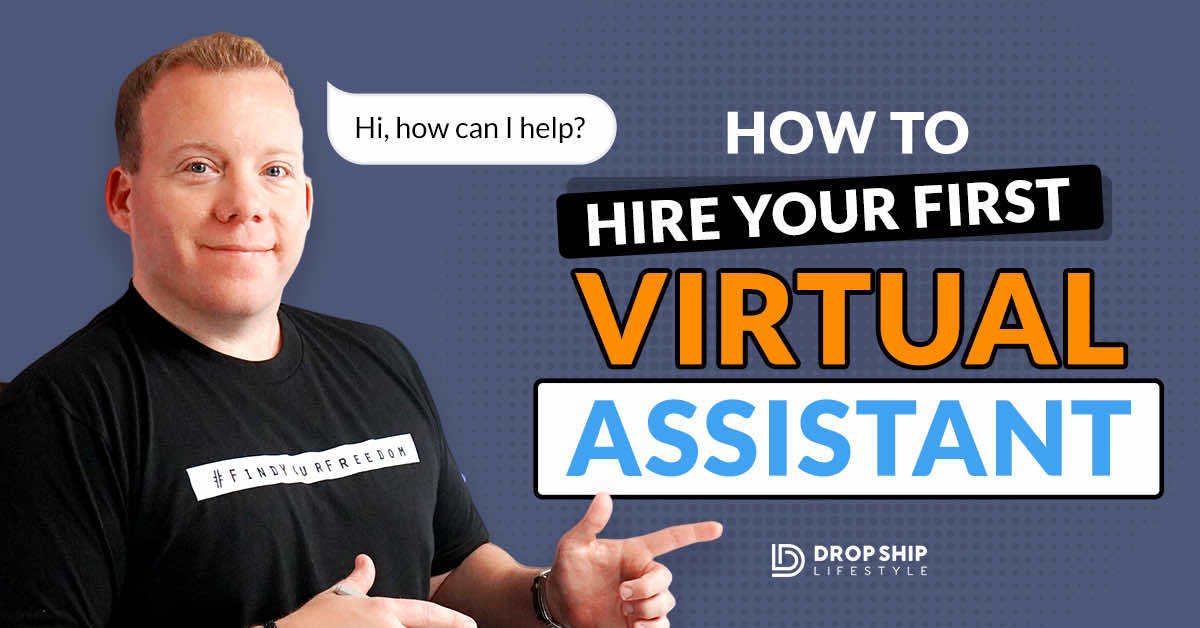
Outsource by hiring virtual assistants to take over basic and repetitive tasks. So you can work as little or as much as you want.
The last part of this step is outsourcing. Basically, you’ll want to hire remote workers (virtual assistants) to take over some of the basic repetitive tasks. The end goal is to set up a business where you work as little or as much as you want.
These are the seven steps that I use to make my stores profitable. It’s what I teach in my course and it’s what has worked for a decade! Now that I briefly covered what you should do to be profitable, I want to talk about what you should avoid.
The last part of the “How to Drop Ship Profitably” series is about the common mistakes newcomers make when starting out.
Part 3: Five Common Dropshipping Mistakes You Should Avoid
After helping 5,000+ members, I’ve spotted the five most common mistakes made by dropshippers. Avoiding these mistakes will save you a lot of time and money. That’s why I’ve created this list so your business won’t suffer from these pitfalls.
Mistake #1: Paying to Access Dropshipping Suppliers
The first mistake is paying for access to a supplier. I’ve literally worked with hundreds of dropship suppliers over the years and I’ve never once paid for access. I don't pay monthly fees to access their product catalog and neither should you.
Any company that charges you to sell their products is a middleman. They are making money off these monthly fees and account activations. What’s worse is that these products aren't going to sell well and there are going to be a ton of competitors. Never pay for access to a supplier.
Mistake #2: Working with Low Quality Suppliers
Never work with suppliers who call themselves dropshippers. Now obviously you’re reading a blog about dropshipping. But the funny thing is whenever I am talking to suppliers, I never use the term “dropshippers”. I never Google my niche keywords plus “dropshippers”. That's not how you find quality suppliers. The good suppliers that you want to work with don’t call themselves “dropshippers”.
The good suppliers won't have that keyword anywhere on their website. Chances are if you call them and mention dropshipping, they are going to be less likely to work with you. You want to use the phrase “online retailer”. You want to present yourself as a real business. Not some guy in his mom's basement, just trying to build an eCommerce store. Thankfully there is a process for finding legitimate suppliers.
Mistake #3: Using Suppliers Who Don’t Enforce MAP
The next common mistake to avoid is working with suppliers who don’t enforce MAP. MAP is a common term in the industry that stands for minimum advertised price. You want to sell for suppliers who have pricing controls.
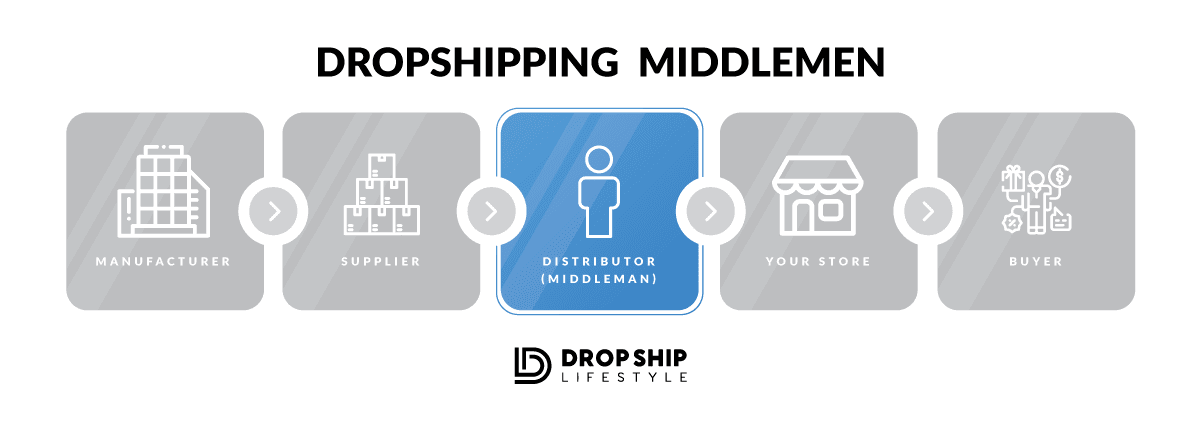
The type of suppliers you want are not middlemen. They’re companies that want retailers that are going to respect their brand, build trust in it, and get them sales. These legitimate companies have pricing controls.
For example, let’s say their brand sells a lady's leather bag and their minimum advertised price is $1000 and your wholesale cost is $600. That means you make $400 per sale. But maybe you’re okay with making $200 per sale, so you want to sell for $800. These suppliers won’t let you do that and will ban you if they catch you doing it. The reason they have these pricing controls is to help their brands hold credibility and value.

They aren’t going to let retailers constantly undercut each other until no one is making money. And more importantly, until the perceived value of their brand goes down. That’s why you only want to work with suppliers that enforce a minimum advertised pricing. Thankfully there are a bunch of ways to check if they do. You could just ask them but there are more automated ways.
Mistake #4: Competing With Offline Retailers
Don’t try to compete with offline retailers. When you’re looking for future competitors, avoid companies that have physical stores or warehouses. They are most likely going to get better pricing from suppliers and be able to sell for less.
Also, if someone has the option of buying something online or going down the block and picking it up the same day, they will most likely choose the latter. One great way to find niches and suppliers is to find unique areas within niches where the products aren't readily available locally, where the customers actually have to buy online.
One quick example is chandeliers. Let's say someone wants to buy a chandelier for their new house. They can go to Home Depot or Lowes. They can find chandeliers but maybe they can't find the exact one they want.
This is an item that has literally thousands of variations and Home Depot carries about 50 different types. Which means a customer probably has to buy online. This is a product that has hundreds of brands and not all of them are going to be in a local store.
You're not going to be the only one competing with these offline retailers. And you’ll focus on the brands that are online only. That’s because you’ll be able to get approved with these brands and actually be able to compete in this space. To recap, avoid directly competing with offline retailers.
Mistake #5: Buying a Turnkey Dropshipping Business
The last mistake that people make all the time is buying a turnkey dropshipping business. If you go to Flippa.com or any of these low-end auction websites you’ll find these stores. They’ll claim, "dropship store, huge opportunity, 5000 products ready to go." But the truth is these don't work. They are all just clones of each other.
These sites are just a way for the sellers to make a quick buck. I can't even see myself, someone that has been in dropshipping for almost a decade, buying one of those and making it profitable. So I am sure no one else is going to. These are a waste of time and money.
Good eCommerce stores and dropshipping stores exist and are for sale. I have sold them, but they go into the mid-high six figure range and I don't think anyone reading this is looking to spend half a million dollars on a website.
That wraps up this three part series. I hope this gives you the motivation to dive in with dropshipping. Remember, the things I’ve shared in this blog are explained in full with membership to Drop Ship Lifestyle.
What was covered:
- Part 1: Explanation of Dropshipping
- Part 2: The Seven Steps to Being Successful in Dropshipping
- Part 3: The Five Most Common Dropshipping Mistakes
Now that you have all three parts of how to dropship profitably, you’re ready to get started on your own dropshipping business. As always, if you have any questions or comments please leave them below.
HERE ARE YOUR NEXT STEPS...
STEP 1:
Join me for my dropshipping masterclass. You'll discover how our members are earning $300 or MORE per sale with the Drop Ship Lifestyle system:
STEP 2:
Just give us a few hours a day for 21 days. That's all that is standing between you and and an online store. By the end, you’ll have built a profitable dropshipping store that is ready to bring in the sales.
Be sure to register for our next free web class. Then, click here to learn how to get your store up and running in three weeks with our system!

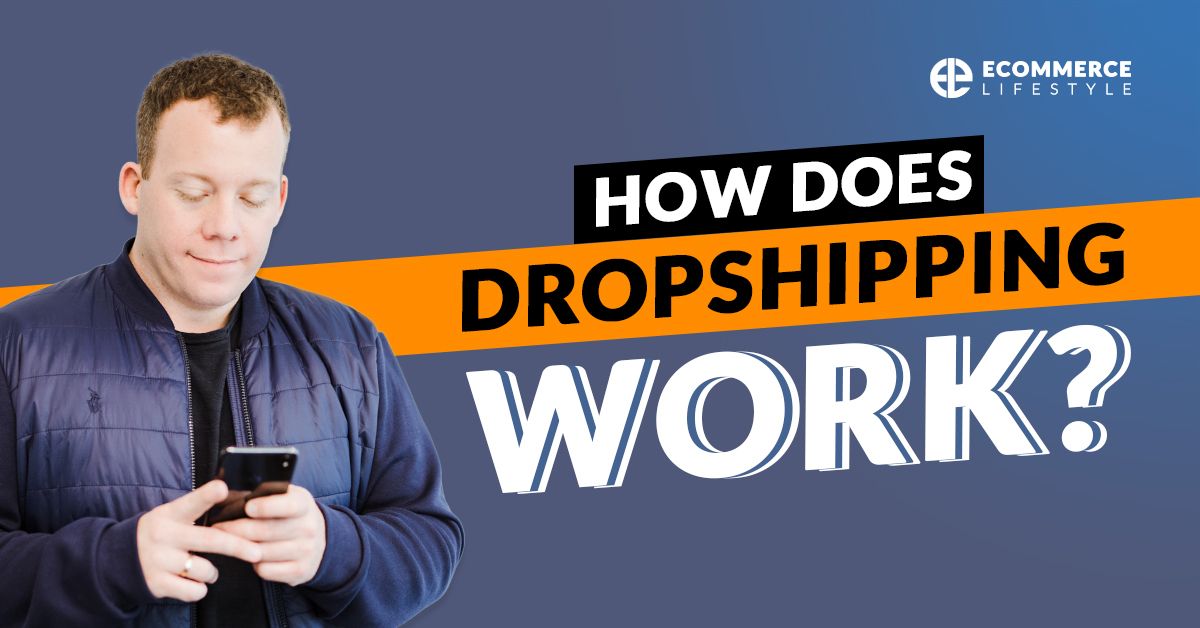

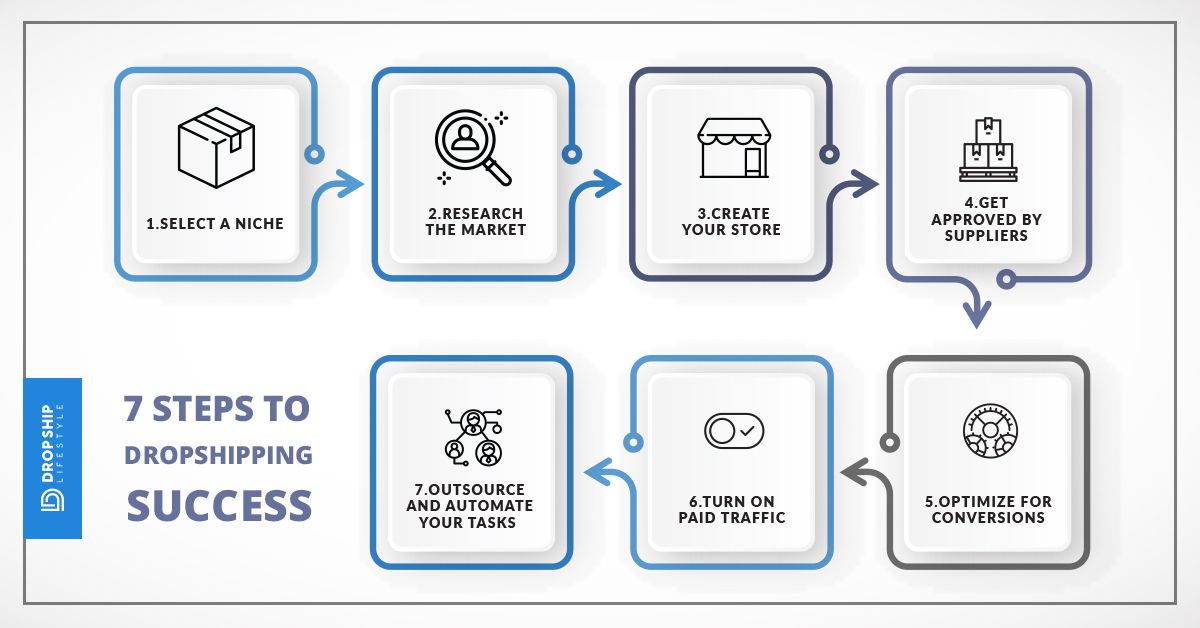

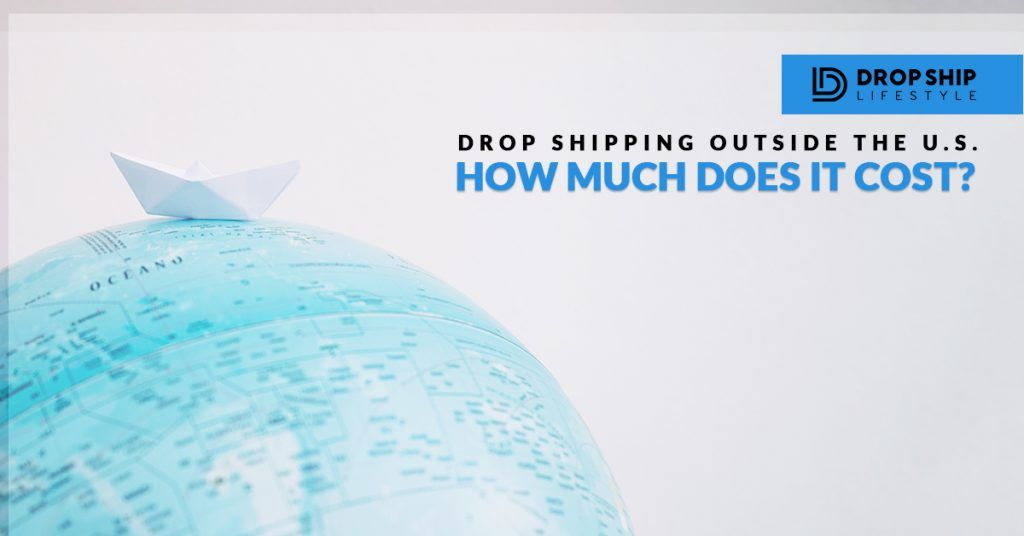


Hey Everyone,
As many of you already know I created Drop Ship Lifestyle after selling a network of eCommerce stores and then trying to find a community of other store owners to network with… What I found was a bunch of scammers who promised newbies they would get rich quick by following their push-button systems!
This led me to create a new community along with an online training program that shares how to build a REAL online business.
I’d love to hear what you think… it’s a 2.5-hour training designed to help you drop ship profitably… all for free.
Be sure to click here to check it out and send me your feedback!
If you go through the “How To Start & Grow A Hyper-Profitable Online Store” webinar and still have questions just contact me and I will help you out.
If I want to do apparel, is that a niche that you help with?
Designer clothes
That’s what I’m looking for. So I’m not sure if this course is best for me unless you can help with that.
Honestly, I would recommend selling products in that niche. Too much customer service and too many returns.
Check out my top 10 best dropshipping niches to get an idea of the types of products that work best.
My business is poultry and livestocks
That’s certainly unique! Hopefully, you’ve got all your permits covered. I wouldn’t even know where to start :p
Second thought, I want to know when we pay for the course does it go very in depth of how to run a online business smoothly and does it give you all the pointers to really launch a business from the ground(as im new to ecommerce and im confused), ive been researching online businesses here and there but i dont want to launch one at all yet without getting the experience as there would be not point in launching one if i dont know what im doing and would just be wasting money
Hi Matt,
Yes, the Drop Ship Blueprint covers everything from A-Z.
I cover everything from business structure and taxes through hiring Virtual Assistants and Outsourcing.
Hello how do I pay for the course and how much will it be,
We have different programs available. Some of them include Done For You services where my team will build your store. You can learn more here: Get Drop Ship Lifestyle.
Hope that helps!
Hi Anton
Useful article. Thanks.
You recommend ‘Shopify’ websites.
Haven’t checked them out personally
but gather there are limitations on
growing them beyond a point.
Your thoughts please.
Thanks
Muhammed
Hi Muhammed,
There really are not any limitations when it comes to scaling eCommerce stores on Shopify. In fact, some of the largest brands in the world are also using Shopify to power their eCommerce stores.
Hi,
I’m curious about Dropship Lifestyle course. If purchased will i be able to use Shopify to do google product listing ads & the rest of the steps you mentioned in your video? Right now I have a store setup selling jewelry threw Shopify plateform. Drop shipping products from Ali express using the free plus shipping model with Facebook ad campaigns. I’ve got sales here & there but not many to really talk about. Well I’m interested in trying your plan since mine haven’t been so profitable. My store is paused right now but can be seen at http://dazzledjewelry.com. Let me know what’s your take on this message.
Thanks
Darnell Tucker
Hi Darnell,
Thanks for reaching out.
If you enroll in our coaching program then yes, you will have access to our Google Adwords Course (and to our Paid Social Traffic Course).
With that being said, I would not recommend Google PLAs for promoting your jewelry store… it’s worth testing, however, Google PLAs work best when you’re selling expensive products.
For that reason my advice would be to go through our course and to follow Module 1 closely. This will help you pick a better (more profitable) niche and then you will be ready to run Google PLAs profitably.
Hope that helps!
Anton